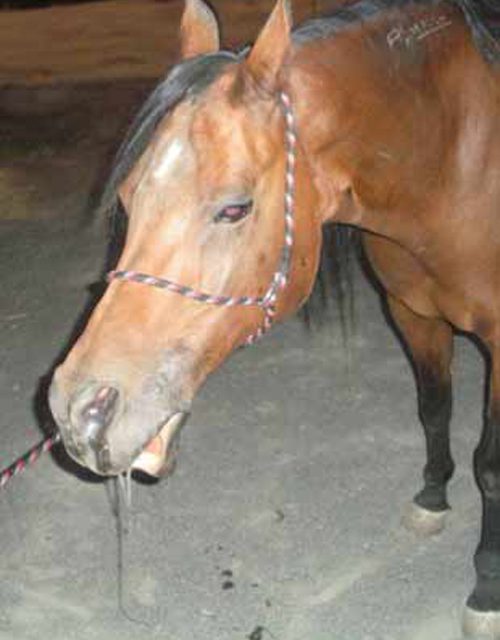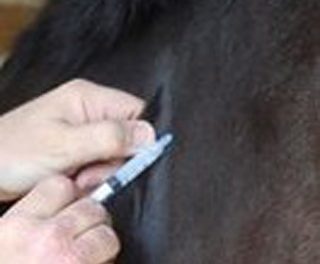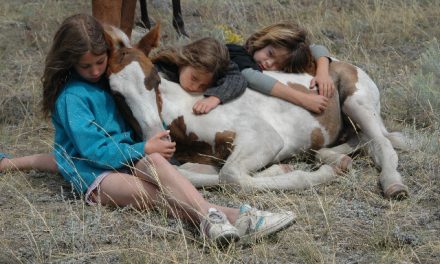 What happens if your horse is bit by a rattlesnake? I asked Dr. Nicola Pusterla of the School of Veterinary Medicine at U.C. Davis this question and others.
What happens if your horse is bit by a rattlesnake? I asked Dr. Nicola Pusterla of the School of Veterinary Medicine at U.C. Davis this question and others.
Where do snake bites usually occur on the horse’s body?
Because of the inquisitive nature of horses, bites usually occur on the muzzle and head of the horse. But bites can also occur on the limbs or other parts of the body.
How can you tell if a horse was bit by a rattlesnake?
The classic signs noted in most horses are an acute onset of swelling and edema (abnormal accumulation of fluid under the skin) at the bite site.
The muzzle and nasal passages may become swollen to the extent that respiration is extremely labored. Death from snakebite is rare in horses.
The clinical signs associated with snakebites are usually the result of the local effects of the venom. Snake venom is a highly complex mixture of enzymes, lipids, biogenic amines, free amino acids, metal ions, protein, and polypeptides. Venom composition and toxic properties vary among snake species and between individuals within the same species.
Factors influencing venom composition include the age of the snake, the time since its last feeding, and seasonal influences related to changes in feeding patterns or physiologic responses such as hibernation. The variation in dose and chemical composition of venom accounts for the extreme amount of variation in the physiologic responses of animals to these substances.
What should you do if your horse is bit by a rattlesnake?
Owners who witness a snake bite should consider it a true emergency. Keep the horse quiet and calm, and call the veterinarian or transport the horse as quickly as possible to a referral hospital.
If the horse is found with a swollen muzzle and nasal passages and is struggling to breathe, short pieces of garden hose–about 10-inches long–can be passed into the nasal passages to maintain breathing. This is essential, since horses are obligate nose-breathers, meaning they only breathe through their noses, not through their mouths.
The administration of anti-inflammatory drugs (phenylbutazone or banamine) can help minimize swelling during the early stages
What does the vet do?
The treatment for a horse that was bitten by a rattlesnake depends on the location of the bite and the severity of the clinical signs. Tracheotomy is indicated in horses that develop excessive edema and swelling of the head and external nares (nose) to the point that respiration becomes impaired. Additional treatment includes the administration of tetanus prophylaxis, systemic antibiotics, and anti-inflammatory.
Animals affected with systemic hypotension (decreased or low blood pressure) or who are unable to eat/drink will benefit from intravenous fluid therapy.
Anti-venom therapy is commonly used in human and small animal snakebites, but it is often considered unnecessary in horses because of financial considerations.
Prevention
The best prevention is to avoid areas infested with rattlesnakes. Unfortunately, there is no vaccine commercially available for horses (such vaccine exists only for small animals).
Dr. Pusterla recommends this excellent article for further reading: “Management of Equine Poisoning and Envenomation” by Gabriele A. Landolt. This article is found on pages 31 – 47 in a book titled “Veterinary Clinics of North America: Equine Practice, Trauma and Emergency Care,” Volume 23, Issue 1, dated April 2007. It’s published by Elsevier Health Sciences. Learn more about this article and book at www.vetequine.theclinics.com/article/S0749-0739(06)00088-5/abstract.
Nicola Pusterla is Associated Professor of Equine Internal Medicine, DVM, Diplomate ACVIM
He graduated form the University of Zurich, Zurich, Switzerland, residency of the ACVIM at Davis. His specialty is in equine internal medicine with an emphasis on infectious diseases.
TWO REAL-LIFE SNAKE BITE CASES
My own veterinarian, Dr. Gary Darling, recently treated two different horses that were bit by rattlesnakes. Fortunately, in both cases, the owners were around at the time of the incident. Also, the owners knew the bites had just happened because they had seen their horses looking and acting normally just a few hours before.
Here is what Dr. Gary had to say about his treatment of these two horses. – Kathleen
Both cases were bites on the nose. The horses presented with a sudden onset of severe swelling of the head, including the jaw and muzzle with loud breathing. Most importantly, I established an airway using approximately 10-inch sections of tubing. After maintaining the airway, another concern is secondary infections. I treated the horses with steroids, non-steroidal anti-inflammatory drugs, and antibiotics.
The swelling dramatically improved in the first 12 to 24 hours in both horse, so I was able to remove the tubes by the next day.
Some horses require more treatment. If the airway cannot be maintained with nasal tubes, then tracheal tube placement is needed. Longer-term care with IV fluids and other types of IV anti-inflammatory drugs, such as DMSO (Dimethyl sulfoxide) might also be needed.
MY STORY
by Patty Walters
It was just an ordinary Friday evening at feeding time…wrong! What a scare to be had.
I went to feed my three “boys,” who were all standing in a row, waiting. Oops, I remembered that I needed to bring hay around from the big barn to feed the horses we board at our place. I gave my apology to the boys, saying I’d be quick to feed the boarders and then I’d come right back.
About 30 minutes later, I headed back to my boys, who were still waiting, except for my “nosey” horse, Tank. I tossed out their feed and called for Tank.
Tank came slowly with his head down. I took one look and yelled for my husband to call the vet now. I put a rope around his neck because a halter would not fit over his nose. His jowls were turning up, I couldn’t find his lips. One nostril was closed and the other was swelling. He wheezed as he tried to breathe.
I grabbed a nasal tube I had on hand and put it into the open nostril. The tube should have been a lot longer. I wasn’t prepared for a snake bite. All I could think of was to put cold water on his face and head until the vet comes. It had been a big snake. The fang marks were a half of an inch apart.
Dr. Darling came in record time. Of course, it was after hours, but who cares at a time like this. He put a tube in Tank’s nose for caution’s sake. He also gave Tank a pain killer and antibiotics, along with a five-day round of medications. The cold water did seem to help stop the continuous swelling.
By the thrid day, you had to look hard to tell Tank had been been bitten. There was just a slight swelling of his lower lips. No skin sloughed from the bite.
For about two weeks, Tank was cautious of where his nose went. But he is still nosey.
The best advice I can give is always take the time to look over your horses at feeding time. If I hadn’t, I may have found a dead horse in the pasture.
I also learned that horses only have about five minutes to live once their airways close up so time is important.
Dr. Darling said a snake vaccine for horses is possible within the next year or two. Currently, there is a vaccine available for dogs.
Keep tubing on hand!
Dr. Darling uses special naso-gastric tubing that has a 1-inch outer diameter (with a 3/4 inch inside diameter). It’s the same tubing he uses for oiling horses that have colic.
But he says horse owners can use a section of garden horse that is 8 to 10-inches long, depending upon the size of the horse. If you have time and you’re preparing the hose section in advance, round the cut edges of the hoses in advance to keep from damaging the horse’s nasal passages.





